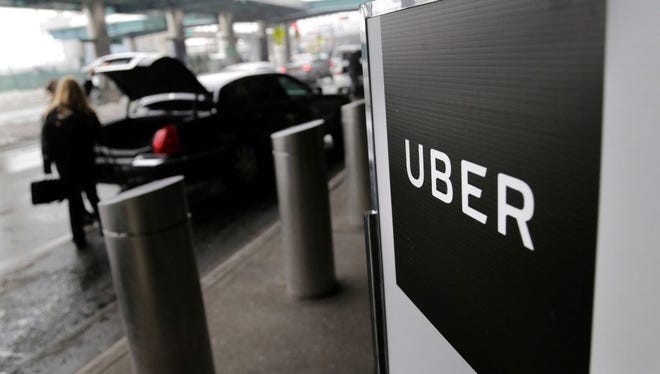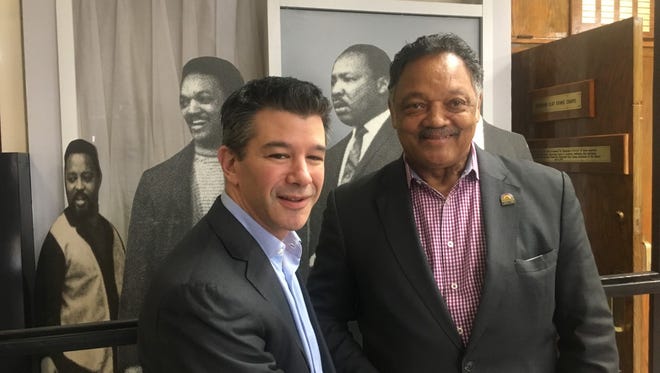Uber looks like the rest of tech: White, Asian and male

SAN FRANCISCO — Uber's first ever diversity report confirms the embattled ride-hailing company faces the same workforce challenges as its tech world peers.
While the company does employ a good number of women, African-Americans and Hispanics, those groups are not well represented among Uber's top leadership and technical positions and instead skew heavily toward support and operational roles.
Of Uber's 12,000 employees worldwide, 63.9% are men. In the U.S., white employees represent 49.8% of the workforce, Asians 30.9%, blacks 8.8% and Hispanics 5.6%.
The diversity scorecard gives Uber low marks for advancing women and people of color into leadership, professional and technical positions in the company.

For example, customer service representatives are 49.7% women, 33.5% black and 15.2% Hispanic. City-based operations staffers are 43.6% women, 18.4% black and 9.3% Hispanic. Yet Uber technical jobs are held by only 15% of women, 1% of blacks and 2.1% of Hispanics.
For leadership, Uber says that globally 22% of women are in such positions and in the U.S. blacks hold 2.3% of leadership positions and Hispanics 0.8%.
"This report is a first step in showing that diversity and inclusion is a priority at Uber," CEO Travis Kalanick said in a statement. "I know that we have been too slow in publishing our numbers, and that the best way to demonstrate our commitment is through transparency."
Uber CEO to Jesse Jackson: Diversity will be priority
Is Uber's self-driving program veering off track?
Uber execs' trip to karaoke hostess bar raised HR complaint
Silicon Valley's dirty little secret: The way it treats women
Diversity has taken on growing urgency in the tech industry, especially in its power center of Silicon Valley.
Tech companies here, staffed mostly by white and Asian men, fear they will lose touch with the diverse nation — and world — that form their consumer base. At the same time, women and minorities are being shut out of one of the fastest-growing, highest-paying sectors of the American economy.
Uber, which had repeatedly refused to release its employee demographics, did so as pressure mounted on the company in the wake of its myriad issues.
Even Uber's own recruiting team did not have access to the demographics, according to Bloomberg News. The lack of data was out of step with a company that obsessively tracks and analyzes every bit of data it can get its hands on and other major tech companies, most of whom have been making annual reports available to the public since 2014.

But releasing the report itself represents a step in the right direction, says Freada Kapor Klein of the Kapor Center. She and her husband Mitch Kapor are Uber investors and wrote a scathing open letter to Kalanick after engineer Susan Fowler wrote her blog post describing a sexist work environment.
"It's great that Uber has now released its numbers," said Kapor Klein. "They have been working on it for a while. They promised their employees they would do it. Now they have delivered on that promise. This is hopefully a first big step in Uber turning the page on changing its culture."
Rashad Robinson, executive director of online racial justice organization Color of Change, said in a statement late Tuesday that while he applauded Uber's newfound transparency, "the onus is now on Kalanick and Uber’s leadership team to prove that all this public soul-searching isn’t just a public relations ploy and to work with advocates and experts to meaningfully increase diversity at the company."
Uber's workforce should eventually echo its driver demographics, says Orson Aguilar, president of The Greenlining Institute, an Oakland, Calif., based activist group.
"We applaud Uber for finally releasing the diversity data it's held onto for so long, but the company still clearly has a long way to go, given its extremely segregated tech workforce," he says. "Uber should strive to have its workforce meet the diversity of its drivers, who are 50% people of color."
A 2016 SurveyMonkey Intelligence report found that Uber's U.S. drivers are mostly male, white, high-school graduates between the ages of 30 and 49 who make less than $50,000 per year. Black drivers represent 28% of the driver pool, while Hispanics are 17%.
Uber's diversity report does not include drivers since they are considered contractors.

"It's a good step but just the first step for Uber," said civil rights leader Jesse Jackson who recently met with Kalanick after pressuring Uber for years to release the demographics of its workforce. "They've still got a ways to go to change their culture but they are at least in the game now."
Kalanick, who stress his newfound commitment to diversity in the meeting with Jackson, is on the hunt for a chief operating officer. Kalanick's at times frat-like behavior over the company's eight-year history has come into focus in the past months, as Uber battles a public relations disaster that has led some customers to delete the app.
In non-technical roles, the sexes almost split jobs evenly, but in technical roles men hold more than 8 out of 10 jobs.
Significantly, Uber's 15.4% of women in technical roles is lower than other major tech companies such as Facebook (17%), Google (19%) and Airbnb (26%).
That paucity of women in engineering roles likely contributed to the sexist environment described by former employee Susan Fowler, whose damning Feb. 19 blog post created Uber's current firestorm. Fowler's male boss made repeated inappropriate advances, and when she reported him to human resources she was told he was a valued employee and nothing could be done.

When looking at Uber's nearly 6,000 U.S. employees, Uber faces an uphill battle trying to diversify a homogeneous workplace, where people of color tend to hold the jobs at the lowest rungs and are shut out of more lucrative and respected jobs in technology or leadership.
Among 851 managers, 19 are African-American and 23 are Hispanic, according to the Equal Employment Opportunity-1 federal diversity data submitted by Uber. Of 4,109 professionals, 89 are African-American and 144 are Hispanic.
Major technology companies such as Facebook and Google release their federal diversity data along with pie charts that illustrate the demographics of their workforces. The EEO-1 is a standard form that companies supply each year to the U.S. Department of Labor that breaks down race, ethnicity and gender of U.S. employees by job classification. Tech companies say those classifications do not adequately reflect the jobs on their payroll.
Uber's human resources chief Liane Hornsey, who is just three months into her post, has pledged to create a more level playing field for job candidates.
Earlier this month, she told reporters on a conference call that Uber changed 1,500 job descriptions to remove language that smacked of unconscious bias and has taken steps to make sure that those who interview job candidates come from diverse backgrounds, among other things.
Despite Uber's withholding of diversity data — build on the grounds of Kalanick's description of Uber as a meritocracy — Uber did hire its first diversity chief in 2015, Damien Hooper-Campbell. But after about a year on the job, Hooper-Campbell decamped for eBay.
In January Uber announced it had hired his replacement: Bernard Coleman, the former chief diversity officer for Hillary Clinton’s presidential campaign. Coleman has his work cut out for him, but Kapor Klein seems optimistic that Uber can make progress.
"What I am struck by is that Uber is not significantly worse than companies that have been around twice as many years and have spent hundreds of millions of dollars on diversity in the last three years and have diversity departments of a dozen people," Klein said, speaking of Uber's much larger tech brethren such as Facebook, Apple and Google.

Follow USA TODAY tech reporters Jessica Guynn and Marco della Cava on Twitter.